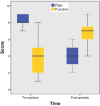Endoscopic Treatment of Greater Trochanteric Pain Syndrome - A Case Series of 11 Patients
- PMID: 31245309
- PMCID: PMC6588147
- DOI: 10.13107/jocr.2250-0685.1284
Endoscopic Treatment of Greater Trochanteric Pain Syndrome - A Case Series of 11 Patients
Abstract
Introduction: Greater trochanteric pain syndrome (GTPS) includes patients with symptoms of peritrochanteric pain, gluteus medius/minimus tendinopathy, and external snapping hip. Non-operative treatment includes iliotibial band (ITB) stretching, gluteal exercises and cortisone injections. When surgery is indicated due to the failure of non-operative strategies, open Z-plasty at the level of the greater trochanter has been the traditional procedure. Endoscopic release of the ITB and bursectomy at the level of the greater trochanter has over the last decades evolved and is established as an alternative method of surgery.
Case reports: We here present a case series with 11 consecutive patients who have undergone endoscopic release of the ITB and bursectomy at the level of the greater trochanter due to GTPS. The patients were all Caucasians, 43-years of age, and six were female. The patients retrospectively scored their pre-operative function and pain during follow-up at 28 months (range 15-42). Post-operative pain and function were scored at follow-up. In this paper, we discuss investigation, differential diagnoses, surgical options, and outcomes in the treatment of GTPS. All patients reported significant reduction of pain, and 10 of 11 patients reported an improvement in function. We observed no complications.
Conclusions: Endoscopic release of the ITB and bursectomy at the level of the greater trochanter appears to be an effective and safe procedure when conservative treatment options for GTPS have failed.
Keywords: Greater trochanteric pain syndrome; Z-plasty; algorithm; endoscopy; iliotibial band.
Conflict of interest statement
Conflict of Interest: Nil
Figures



Similar articles
-
Endoscopic Distal Iliotibial Band Z-Plasty for Greater Trochanteric Pain Syndrome.Arthrosc Tech. 2024 Nov 16;14(4):103307. doi: 10.1016/j.eats.2024.103307. eCollection 2025 Apr. Arthrosc Tech. 2024. PMID: 40453003 Free PMC article.
-
The outcome of endoscopy for recalcitrant greater trochanteric pain syndrome.Arch Orthop Trauma Surg. 2016 Nov;136(11):1547-1554. doi: 10.1007/s00402-016-2511-z. Epub 2016 Jul 12. Arch Orthop Trauma Surg. 2016. PMID: 27405492
-
[Clinical Results of Endoscopic Treatment of Greater Trochanteric Pain Syndrome].Acta Chir Orthop Traumatol Cech. 2017;84(3):168-174. Acta Chir Orthop Traumatol Cech. 2017. PMID: 28809635 Czech.
-
Endoscopic Treatment of Gluteus Medius Tears: A Review.Bull Hosp Jt Dis (2013). 2016 Mar;74(1):58-62. Bull Hosp Jt Dis (2013). 2016. PMID: 26977550 Review.
-
Hip Abductor and Peritrochanteric Space Conditions.Clin Sports Med. 2021 Apr;40(2):311-322. doi: 10.1016/j.csm.2021.01.001. Epub 2021 Feb 5. Clin Sports Med. 2021. PMID: 33673889 Review.
Cited by
-
Short-term outcomes following mini-open repair of chronic gluteus medius tendon tears using a double-row technique.J Hip Preserv Surg. 2021 Aug 25;8(2):202-208. doi: 10.1093/jhps/hnab060. eCollection 2021 Jul. J Hip Preserv Surg. 2021. PMID: 35145719 Free PMC article.
-
Good functional outcomes after endoscopic treatment for greater trochanteric pain syndrome.J Exp Orthop. 2023 Mar 15;10(1):26. doi: 10.1186/s40634-023-00574-3. J Exp Orthop. 2023. PMID: 36918447 Free PMC article.
-
Endoscopic management of greater trochanteric pain syndrome (GTPS): a comprehensive systematic review.Eur J Orthop Surg Traumatol. 2024 Aug;34(6):3385-3394. doi: 10.1007/s00590-024-04019-0. Epub 2024 Jun 11. Eur J Orthop Surg Traumatol. 2024. PMID: 38862847 Free PMC article.
-
Gluteal Complex is important in External Snapping Hip: intraoperative identification of syndrome origin and endoscopic stepwise release-a case series.Int Orthop. 2024 Feb;48(2):401-408. doi: 10.1007/s00264-023-05961-0. Epub 2023 Sep 5. Int Orthop. 2024. PMID: 37668725 Free PMC article.
-
Ultrasound-guided Platelet-rich Plasma Application Versus Corticosteroid Injections for the Treatment of Greater Trochanteric Pain Syndrome: A Prospective Controlled Randomized Comparative Clinical Study.Cureus. 2020 Jan 7;12(1):e6583. doi: 10.7759/cureus.6583. Cureus. 2020. PMID: 32051796 Free PMC article.
References
-
- Williams BS, Cohen SP. Greater trochanteric pain syndrome:A review of anatomy, diagnosis and treatment. Anesth Analg. 2009;108:1662–70. - PubMed
-
- Redmond JM, Chen AW, Domb BG. Greater trochanteric pain syndrome. J Am Acad Orthop Surg. 2016;24:231–40. - PubMed
-
- Klauser AS, Martinoli C, Tagliafico A, Bellmann-Weiler R, Feuchtner GM, Wick M, et al. Greater trochanteric pain syndrome. Semin Musculoskelet Radiol. 2013;17:43–8. - PubMed
Publication types
LinkOut - more resources
Full Text Sources
